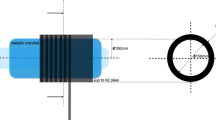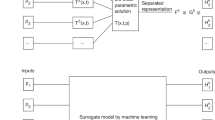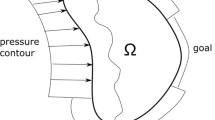Abstract
To ensure correct filling in the resin transfer molding (RTM) process, adequate numerical models have to be developed in order to correctly capture its physics, so that this model can be considered for process optimization. However, the complexity of the phenomenon often makes it impossible for numerical models to accurately predict its behavior, limiting its usage. To overcome this limitation, numerical models are enriched with measured data to ensure their correct predictability. Nevertheless, the data used is often limited due to practical constraints, such as a limited number of sensors or the high costs of experimental campaigns. In this context, the present paper demonstrates the implementation of a numerical model enriched with data, called Hybrid Twin applied to the RTM process when few sensors are considered in the mold to be injected. The performances of the developed hybrid twin are tested in a virtual test for the injection of a 2D mold, where the hybrid twin constructed using a simplified numerical model allows to accurately predict a complex model’s resin flow-front over its entire time history.












Similar content being viewed by others
Availability of data and materials
Not applicable
Code availability
Provided under request.
References
Fong L, Advani S (1998) Resin transfer molding. Handbook of composites. Springer, Boston, pp 433–455
Potter KD (1999) The early history of the resin transfer moulding process for aerospace applications. Composites Part A: Appl Sci Manuf 30(5):619–621
Zienkiewicz OC, Taylor RL (2005) The Finite Element Method for Solid and Structural Mechanics. Elsevier, Amsterdam
Smith GD, Smith GD, Smith GDS (1985) Numerical Solution of Partial Differential Equations: Finite Difference Methods. Oxford University Press, Oxford
Chinesta F, Cueto E, Abisset-Chavanne E, Duval JL, Khaldi FE (2020) Virtual, digital and hybrid twins: A new paradigm in data-based engineering and engineered data. Archives Comput Methods Eng 27(1):105–134
Russell SJ (2010) Artificial Intelligence a Modern Approach. Pearson Education Inc, New York
Goodfellow I, Bengio Y, Courville A (2016) Deep Learn. MIT press, MA, USA
Wani MA, Bhat FA, Afzal S, Khan AI (2020) Advances in Deep Learning. Springer, Singapore
Gulli A, Pal S (2017) Deep Learning with Keras. Packt Publishing Ltd, Birmingham, UK
Moya B, González D, Alfaro I, Chinesta F, Cueto E (2019) Learning slosh dynamics by means of data. Comput Mech 64(2):511–523
Reille A, Hascoet N, Ghnatios C, Ammar A, Cueto E, Duval JL, Chinesta F, Keunings R (2019) Incremental dynamic mode decomposition: A reduced-model learner operating at the low-data limit. Comptes Rendus Mécanique 347(11):780–792
Hernández Q, Badías A, González D, Chinesta F, Cueto E (2021) Structure-preserving neural networks. J Comput Phys 426:109950
Sancarlos A, Cameron M, Le Peuvedic J-M, Groulier J, Duval J-L, Cueto E, Chinesta F (2021) Learning stable reduced-order models for hybrid twins. Data-Centric Engineering 2
Sancarlos A, Cameron M, Abel A, Cueto E, Duval J-L, Chinesta F (2021) From rom of electrochemistry to ai-based battery digital and hybrid twin. Archives Comput Methods Eng 28(3):979–1015
Champaney V, Chinesta F, Cueto E (2022) Engineering empowered by physics-based and data-driven hybrid models: A methodological overview. Int J Mater Form 15(3):1–14
Ladevèze P (1985) Sur une famille d’algorithmes en mécanique des structures. Comptes-rendus des séances de l’Académie des sciences. Série 2, Mécanique-physique, Chimie, Sciences de l’univers, Sciences de la Terre 300(2):41–44
Boucard P-A, Ladevèze P (1999) A multiple solution method for non-linear structural mechanics. Mech Eng 50:317–328
Ladevèze P, Passieux J-C, Néron D (2010) The latin multiscale computational method and the proper generalized decomposition. Comput Methods Appl Mech Eng 199(21–22):1287–1296
Relun N, Néron D, Boucard P-A (2011) Multiscale elastic-viscoplastic computational analysis: a detailed example. European Journal of Computational Mechanics/Revue Européenne de Mécanique Numérique 20(7–8):379–409
Relun N, Néron D, Boucard P-A (2013) A model reduction technique based on the pgd for elastic-viscoplastic computational analysis. Comput Mech 51(1):83–92
Néron D, Boucard P-A, Relun N (2015) Time-space pgd for the rapid solution of 3d nonlinear parametrized problems in the many-query context. Int J Numer Methods Eng 103(4):275–292
Rodriguez S, Néron D, Charbonnel P-E, Ladevèze P, Nahas G (2019) Non incremental latin-pgd solver for non-linear vibratoric dynamics problems. In: 14ème Colloque National en Calcul des Structures, CSMA 2019
Iturra SR (2021) Abaques virtuelle pour le génie parasismique incluant des parametres associes au chargement. PhD thesis, Université Paris-Saclay
Ammar A, Mokdad B, Chinesta F, Keunings R (2006) A new family of solvers for some classes of multidimensional partial differential equations encountered in kinetic theory modeling of complex fluids. J Non-Newtonian Fluid Mech 139(3):153–176
Chinesta F, Ammar A, Cueto E (2010) Recent advances and new challenges in the use of the proper generalized decomposition for solving multidimensional models. Archives Comput Methods Eng 17(4):327–350
Chinesta F, Cueto E (2014) PGD-based Model Mater. Structures and Processes, Springer, Switzerland
Torregrosa S, Champaney V, Ammar A, Herbert V, Chinesta F (2022) Surrogate parametric metamodel based on optimal transport. Mathematics and Computers in Simulation 194:36–63
Ammar A, Chinesta F, Cueto E, Doblaré M (2012) Proper generalized decomposition of time-multiscale models. Int J Numer Methods Eng 90(5):569–596
Ibáñez R, Ammar A, Cueto E, Huerta A, Duval J-L, Chinesta F (2019) Multiscale proper generalized decomposition based on the partition of unity. Int J Numer Methods Eng 120(6):727–747
Pasquale A, Ammar A, Falcó A, Perotto S, Cueto E, Duval J-L, Chinesta F (2021) A separated representation involving multiple time scales within the proper generalized decomposition framework. Adv Model Simul Eng Sci 8(1):1–22
Passieux J-C, Ladevèze P, Néron D (2010) A scalable time-space multiscale domain decomposition method: adaptive time scale separation. Comput Mech 46(4):621–633
Lee JA, Verleysen M (2007) Nonlinear Dimensionality Reduction. Springer, New York
Ibáñez R, Abisset-Chavanne E, Ammar A, González D, Cueto E, Huerta A, Duval JL, Chinesta F (2018) A multidimensional data-driven sparse identification technique: the sparse proper generalized decomposition. Complexity 2018
Sancarlos A, Champaney V, Duval J-L, Cueto E, Chinesta F (2021) Pgd-based advanced nonlinear multiparametric regressions for constructing metamodels at the scarce-data limit. arXiv:2103.05358
Sancarlos A, Cueto E, Chinesta F, Duval J-L (2021) A novel sparse reduced order formulation for modeling electromagnetic forces in electric motors. SN Appl Sci 3(3):1–19
Quaranta G, Abisset-Chavanne E, Chinesta F, Duval J-L (2018) A cyber physical system approach for composite part: From smart manufacturing to predictive maintenance. In: AIP conference proceedings, vol 1960, AIP Publishing LLC, pp 020025
Sánchez F, García J, Chinesta F, Gascón L, Zhang C, Liang Z, Wang B (2006) A process performance index based on gate-distance and incubation time for the optimization of gate locations in liquid composite molding processes. Composites Part A: Applied Science and Manufacturing 37(6):903–912
Garcıa J, Gascón L, Chinesta F (2003) A fixed mesh numerical method for modelling the flow in liquid composites moulding processes using a volume of fluid technique. Comput methods Appl Mech Eng 192(7–8):877–893
Sanchez F, Garcia JA, Gascón L, Chinesta F (2007) Towards an efficient numerical treatment of the transport problems in the resin transfer molding simulation. Comput Methods Appl Mech Eng 196(21–24):2300–2312
Quaranta G (2019) Efficient simulation tools for real-time monitoring and control using model order reduction and data-driven techniques. Universitat politécnica de Catalunya, Thesis, École centrale de Nantes
Ghnatios C, Masson F, Huerta A, Leygue A, Cueto E, Chinesta F (2012) Proper generalized decomposition based dynamic data-driven control of thermal processes. Comput Methods Appl Mechan Eng 213:29–41
Dennis JE Jr, Schnabel RB (1996) Numerical Methods for Unconstrained Optimization and Nonlinear Equations. SIAM, Philadelphia, Penn
Gavin HP (2019) The levenberg-marquardt algorithm for nonlinear least squares curve-fitting problems. Duke University, Department of Civil and Environmental Engineering, p 19
Karhunen K (1946) Zur spektraltheorie stochastischer prozesse. Ann. Acad. Sci, Fennicae, AI, p 34
Loeve M (1948) Fonctions aléatoires du second ordre. Lévy, Processus Stochastiques et Mouvement Brownien, Gauthier-Villars, Paris
Everson R, Sirovich L (1995) Karhunen-loeve procedure for gappy data. JOSA A 12(8):1657–1664
Fasshauer GE (2007) Meshfree Approximation Methods with MATLAB, vol 6. World Scientific, Hackensack, NJ
Acknowledgements
The European MORPHO project is gratefully acknowledged for funding this research activity.
Funding
This research was funded by the H2020 programme, under EU.3.4. - Societal Challenges - Smart, Green And Integrated Transport.
Author information
Authors and Affiliations
Contributions
Conceptualization, F.C., E.M., M.R, N.M.; methodology, S.R.; software, S.R.; supervision, F.C., E.M., M.R, N.M. All authors have read and agreed to the published version of the manuscript.
Corresponding author
Ethics declarations
Ethics approval
Not applicable
Consent to participate
Not applicable
Consent for publication
Yes
Conflicts of interest
The authors declare that they have no conflict of interest.
Additional information
Publisher's Note
Springer Nature remains neutral with regard to jurisdictional claims in published maps and institutional affiliations.
All authors contributed equally to this work.
Appendix A: Approximation of sparse data; the sparse - PGD
Appendix A: Approximation of sparse data; the sparse - PGD
In real-life situations, having access to abundant and structured data is not always possible. In this situation a direct application of the PGD method is unfortunately not possible. To solve this limitation, in [33] an extension of the PGD method was proposed to deal with unstructured data and overcome in this sense the curse of dimensionality. This method is called sparse-PGD.
To illustrate the main ideas on how to determine the PGD decomposition for the case of sparse data, an approximation of a function \(f(\nu _{1},\nu _{2}) \in \mathbb {R}^{2} \rightarrow \mathbb {R}\) is considered here, where its value is known over some P sampling points. In this case, the PGD decomposition is simply determined by solving the following minimization problem:
with \(\left\| {\bullet }\right\| _{2}^{2} = \int _{{\Omega }} (\bullet )^{2} \ d\nu _{1} d\nu _{2}\) and \({\Omega } = {\Omega }_{\nu _{1}} \times {\Omega }_{\nu _{2}}\). From the last expression, \(u_{m}(\nu _{1},\nu _{2})\) corresponds to the PGD decomposition of \(f(\nu _{1},\nu _{2})\), where m terms are considered, this is:
with \(X_{1}^{k}(\nu _{1})\) and \(X_{2}^{k}(\nu _{2})\), \(\forall k \in [1, ... , m]\) the separate variable functions to be determined. Here the PGD functions are not interpolated using, for example, the Finite Element Method (FEM) [3], in this case the functions used are globally defined over the whole interval considered for each variable. The functions that can be used could be for instance, Kriging interpolants functions [33] or radial basis functions [47], just to cite a few. In this context, the PGD functions for the 2D case are constructed as follows:
where \({N_{j}^{k}}(\nu _{i})\) and \(a^{k}_{\nu _{i},j}\) denotes the shape functions and its respective nodal value for variable \(\nu _{i}\) evaluated on the control point j at PGD mode k. If the shape functions are considered to be radial functions of multiquadric type [47], they are given as follows:
with \((\nu _{i})_{j}\) the coordinate of the control point associated to variable \(\nu _{i}\) and c a parameter that drives the shape of the function, chosen such as it allows a non over-fitted PGD approximation. These PGD functions are classically determined one after the other in an incremental way, also denoted Greedy process. That is, one considers as known \(m-1\) terms of the decomposition Eq. A2, and seeks the determination of the mode m, i.e., \(u_{m}(\nu _{1},\nu _{2}) = u_{m-1}(\nu _{1},\nu _{2}) + X_{1}^{m}(\nu _{1}) X_{2}^{m}(\nu _{2})\). In this case one reformulates Eq. A1 as follows:
with \(f_{\text {res}}(\nu _{1},\nu _{2}) = f(\nu _{1},\nu _{2}) - u_{m-1}(\nu _{1},\nu _{2})\). By minimizing the expression Eq. A6 yields:
\(\forall {w}^{*}(\nu _{1},\nu _{2}),\)
However since the information is just known at P sampling points \(( (\nu _{1})_{i},(\nu _{2})_{i}), \forall i \in [1,...,P]\), the test function \({w}^{*}(\nu _{1},\nu _{2})\) is expressed as a set of Dirac delta functions collocated at these points, this is:
where \(\delta ( (\nu _{1})_{i}, (\nu _{2})_{i} )\) here denotes the delta Dirac function evaluated at points \(((\nu _{1})_{i}, (\nu _{2})_{i})\). By replacing \({w}^{*}(\nu _{1},\nu _{2})\) by its sparse version of Eqs. A8 into A7, and developing the expression yields the problems that must be solved to obtain the PGD functions:
Compute \(X_{1}^{m}(\nu _{1})\) by solving:
Compute \(X_{2}^{m}(\nu _{2})\) by solving:
Equations A9 and A10 should be solved alternatively following a fixed-point strategy, where for the resolution of Eq. A9 one considers known the value of function \(X_{2}^{m}(\nu _{2})\), and for the resolution of Eq. A10 one considers \(X_{1}^{m}(\nu _{1})\) known. To illustrate this resolution, but only for the determination of \(X_{1}^{m}(\nu _{1})\), lets define:
where \(\otimes\) denotes a Kronecker tensor product. By using the operators defined in Eq. A11 and approximations of Eq. A3 and A4, one obtains the following system of equations needed to be solved to compute the discretized DOFs related to \(X_{1}^{m}(\nu _{1})\) (\(\underline{\varvec{a}} ^{m}_{\nu _{1}}\)).
where the matrix and vector are respectively given as:
The extension of the above method to the case of a multidimensional function is straightforward and follows the same methodology, for this case one has:
where:
with \(\left\| {\bullet }\right\| _{2}^{2} = \int _{{\Omega }} (\bullet )^{2} \ d \nu _{1} d \nu _{2} \ ... \ d \nu _{n}\), where for this case \({\Omega } = {\Omega }_{\nu _{1}} \times {\Omega }_{\nu _{2}} \times ... \times {\Omega }_{\nu _{n}}\). For this case the same resolution procedure by the fixed-point technique must be applied. The determination of the nodal values of the m PGD function corresponding to parameter \(\nu _{q}\) with \(q \in [1, ... , n]\) is simply given as:
where the respective matrix and vector are computed as follows:
with \(f_{\text {res}}(\nu _{1},\nu _{2}, ... \ , \nu _{n}) = f(\nu _{1},\nu _{2}, ... \ , \nu _{n}) - u_{m-1}(\nu _{1},\nu _{2},\) \(... \ , \nu _{n})\).
Rights and permissions
Springer Nature or its licensor (e.g. a society or other partner) holds exclusive rights to this article under a publishing agreement with the author(s) or other rightsholder(s); author self-archiving of the accepted manuscript version of this article is solely governed by the terms of such publishing agreement and applicable law.
About this article
Cite this article
Rodriguez, S., Monteiro, E., Mechbal, N. et al. Hybrid twin of RTM process at the scarce data limit. Int J Mater Form 16, 40 (2023). https://doi.org/10.1007/s12289-023-01747-2
Received:
Accepted:
Published:
DOI: https://doi.org/10.1007/s12289-023-01747-2




